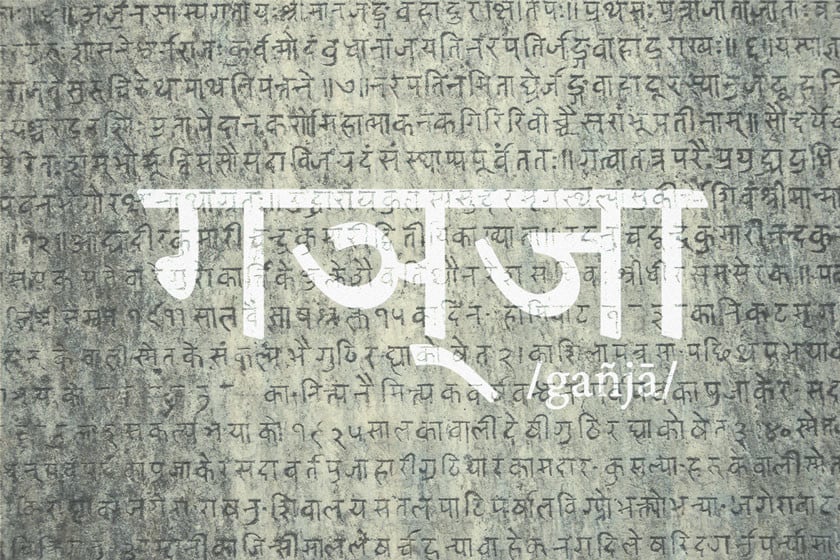.

Origins and Modern Use of Ganja
There are hundreds of words for cannabis, but none of them bear the same historical significance as "ganja". This ancient word has roots in Sanskrit, and the plant itself played an important role in the religious practices and medical systems of the Hindu world. Discover the origins of this famous term, and how it reached the West.
Contents:
Ganja. This word permeates the global cannabis space. You’ll see these five letters plastered on websites, storefronts, smoking products, and seed packets. The casual use of this term means it often gets lumped in with many other stoner slang words. But ganja has ancient roots and a fascinating story. Discover the origins of the word and how it became so dominant in cannabis culture.
There Are Many Words for Weed
Think about this for a second: you likely know more synonyms for cannabis than any other noun. There are hundreds of names for the plant and the flowers it produces. While some of these names have botanical roots, many of them are classed as slang. Because cannabis has a controversial history, users often came up with names to conceal the topic of their discussions. Of course, as these titles gained traction, they had to switch to new ones in the interest of discretion. Some of the most widely used names for cannabis include:
| Weed | Ganja | Pot | Reefer | Bud | Grass | Herb | Green |
| Weed | Ganja |
| Pot | Reefer |
| Bud | Grass |
| Herb | Green |
But one of these words is not like the rest. Cannabis users often assume the word “ganja” descends from Jamaican slang. Although the term has a history on the Caribbean island, it spans much further back into antiquity.
India: The Roots of Ganja
Cannabis has a long and rich history in India. Although the herb likely originated in modern-day China[1], the plant eventually arrived within India’s borders, where it fulfiled a significant role as a holistic herb and religious sacrament. The use of the plant dates back to as early as 2000 BCE in the region.
Various ancient texts are thought to make reference to cannabis. Some scholars propose cannabis as a candidate for the intoxicating ritualistic preparation called soma during the Vedic period. The Rigveda, penned between 1700–1100 BCE, reveres this mind-altering concoction. The Atharvaveda, composed between 1500–1000 BCE, also mentions a sacred plant, known as “bhanga”, used to relieve anxiety.
However, these references remain contested. The documents are written in the ancient language of Sanskrit—one of the oldest and most systematic languages in the world. This antiquated linguistic system is complex; for example, it features around 70 synonyms for water and 100 names for elephants.
The term ganja originates from this mother language in the form of the word “gañjā”, which refers to a preparation made using cannabis. The term also carried over into Hindi, a newer Indo-Aryan language that descended from an early form of Vedic Sanskrit. The word looks extremely similar in Hindi—“gāñjā”.
But the word only refers to a certain product derived from cannabis plants. Gāñjā is the title given to the flowers, whereas “charas” refers to the resin, and “bhang” the seeds and leaves.
The impact of Sanskrit on cannabis terminology remains in the modern era. Not only do we still use these terms, but researchers have used the ancient language to name new cannabis-related molecules.
The esteemed cannabis researcher Raphael Mechoulam discovered THC—the main psychoactive constituent of the plant—in 1964. In 1992, in an effort to understand the effects of cannabis on the body, he discovered a critical endocannabinoid that he named “anandamide”. This term stems from the Sanskrit “ananda”, which translates to “bliss” or “joy”. Interestingly, researchers believe this molecule underpins the euphoric sensations of the “runner’s high”.
The word ganja has a rich history indeed. But how exactly did this ancient Sanskrit term become a key part of the global cannabis vernacular? It involves unbelievable cruelty, the merging of cultures, and the birth of a new religion.

A Flame in the Darkness: Ganja's Contribution to Rastafari
The word ganja didn’t reach the Western world through some kind of cultural outreach or mission. Instead, it arrived in shackles at the hands of colonialism and slavery. In 1845, the British Empire started to traffic enslaved Indians to the Caribbean to strengthen the workforce on sugar plantations. Over 40,000 of them arrived in Jamaica from India over the subsequent decades.
Captured slaves lost a lot during the voyage; family, freedom, and homeland. But the treacherous journey couldn’t quite shake away elements of their culture. Some of these slaves brought a little piece of home along with them, including ganja.
Slaves from elsewhere in the world arrived at the island hundreds of years earlier; victims of the Atlantic slave trade from Africa were brought to Jamaica in 1513. As the British trafficked Indians to the island, they unintentionally developed a melting pot of cultures. Their synergy would go on to affect the world, and all things cannabis, forever.
Christian missionaries spread the Gospel to Jamaica, and members of the large African population there gave it their own cultural spice. This fusion of religion and culture gave rise to Rastafari, a religion based on the Bible. However, Rastas hold some opposing views to many sects of Christianity. They believe that Heaven is on Earth, that God’s spirit manifests as Emperor Haile Selassie I, and they put a large emphasis on the spiritual significance of ganja.
The slave trade has left a dark strain on humanity. But there are silver linings in all things. Although defined by horrific acts of evil, a light flickered during this time. The meshing of cultures that occurred gave life to a new belief system—one grounded in hope, nature, and peace.
Overall, a blend of Christianity, African culture, and the Indian roots of ganja gave rise to Rastafari. Interestingly, the holy men of both Rastafari and Hinduism share a few things in common. For example, both devoted Rastas and sadhus sport dreadlocks and engage in ganja smoking using simple implements such as chillums and chalices.
The Modern Use of “Ganja”
Cultural figureheads such as Bob Marley popularised Rastafari and ganja through reggae music, and recognition of both quickly soared in Western culture. To this day, the word ganja is largely associated with Jamaican culture. Although the origin of the word receives little attention, the term itself appears almost everywhere in the Western cannabis space, from dispensaries and seed banks to music and films. There is, of course, nothing wrong with this, so long as we respect the history of this now-omnipresent term.
- Large-scale whole-genome resequencing unravels the domestication history of Cannabis sativa | Science Advances https://advances.sciencemag.org






































